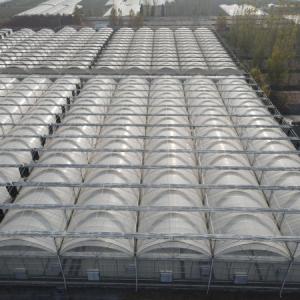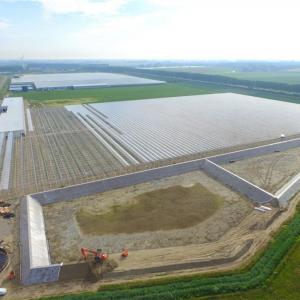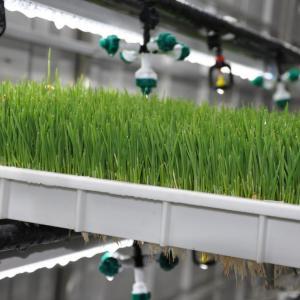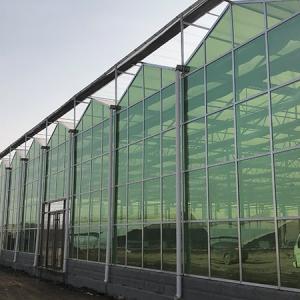Service Life of Greenhouse Glass: Influencing Factors and Extension Strategies
Service Life of Greenhouse Glass: Influencing Factors and Extension Strategies
In high-end protected agricultural projects such as multi-span intelligent greenhouses, glass has become an irreplaceable covering material due to its core advantages of stable light transmittance, outstanding weather resistance, and long service life. Its service duration not only directly determines the long-term operation cost and planting stability of the greenhouse, but also profoundly affects the value preservation ability of agricultural assets. Currently, the industry generally sets the design service life of greenhouse glass at 20 years. However, in practical applications, this indicator varies significantly depending on material quality, construction technology, environmental conditions, and operation and maintenance levels. This article will analyze from three dimensions: core influencing factors, service life reference of mainstream glass, and practical measures to extend service life, providing systematic guidance for practitioners.
I. Decoding the Core Influencing Factors of Greenhouse Glass Service Life
1. Material and Quality: "Innate Genes" Determining Service Life
The basic service life of glass is determined by its "innate quality", with raw material purity and production technology forming the core guarantee. Currently, mainstream high-quality greenhouse glass mostly uses borosilicate or float glass as the base material. Through precise formula control, this type of glass not only has excellent thickness uniformity, but also possesses high-strength mechanical properties and anti-aging characteristics. After further tempering processing, its impact resistance can be increased to 3-5 times that of ordinary glass, effectively reducing the risk of spontaneous explosion.
In sharp contrast, inferior glass—produced by some manufacturers using remelted recycled glass or simplified production processes—often has hidden dangers such as uneven internal stress distribution and impurity precipitation. In the greenhouse environment, it is prone to sudden spontaneous explosion or structural cracking, and its service life may be shortened to less than 1/3 of that of high-quality products. It is worth noting that the functional coatings on the glass surface are also crucial. The adhesion of anti-reflective coatings and the wear resistance of dust-proof coatings will directly affect the long-term light transmission stability and structural safety of the glass.
2. Installation Technology and Supporting Systems: "Engineering Barrier" for Protecting Service Life
If glass quality is regarded as the "innate gene", then installation technology and supporting systems are the "acquired barrier" for ensuring service life, among which the three links of frame sealing, installation accuracy, and drainage design are particularly critical.
In terms of the frame and sealing system, the anti-corrosion effect and surface flatness of the greenhouse's steel structure and aluminum alloy frame directly affect the stress state of the glass. If the frame is deformed or the anti-corrosion layer peels off, it will cause concentrated stress on local areas of the glass, leading to cracking. The selection and construction of sealant form the "first waterproof line": high-quality silicone rubber or polysulfide rubber can maintain elasticity in the temperature range of -40℃ to 80℃, while inferior sealant often exhibits aging, shrinkage, cracking, and water seepage within 1-2 years, eventually causing frame corrosion and damp damage to the glass edges.
The control of installation accuracy cannot be ignored either. A cutting size deviation of more than 2mm or uneven extrusion force during installation will artificially generate internal stress. Detail omissions such as unchamfered glass edges and lack of buffer rubber pads at the contact points with the frame will lead to frequent edge chipping when temperature and humidity change or slight vibrations occur. In addition, unreasonable drainage system design will cause rainwater to remain on the glass surface for a long time or seep into the greenhouse along the joints, accelerating the aging of the sealing system and the corrosion of the glass itself.
3. Environmental Factors: "External Variables" Affecting Service Life
The service environment of greenhouse glass is complex and changeable. Extreme weather, temperature and humidity fluctuations, and various erosion factors together constitute the "external variables" affecting its service life. Extreme weather is the most direct destructive factor: strong winds above level 8 can easily cause resonance tearing between the glass and the frame, and hailstones with a diameter of more than 5mm can directly cause ordinary tempered glass to break. The disaster risk of greenhouses without protective nets increases by 40%.
The long-term effects of temperature, humidity, and temperature difference are more hidden. In northern winter, the temperature difference between day and night inside and outside the greenhouse can often exceed 30℃. The thermal expansion and contraction of the glass easily generate internal stress, and long-term repetition will lead to micro-cracks at the edge seals. The high temperature (30-40℃) and high humidity (above 80%) environment inside the greenhouse will accelerate the aging process of the sealant, indirectly shortening the effective service life of the glass.
Chemical and physical erosion should also not be underestimated. Volatile acidic gases from pesticides and chemical fertilizers in the greenhouse may gradually erode the functional coatings on the glass surface. Long-term adhesion of sand and particulate matter in the air will cause abrasion to the glass surface under rainwater scouring, reducing light transmittance and structural stability.
II. Mainstream Greenhouse Glass Types and Service Life Reference
Combined with industry practical data, different types of greenhouse glass show significant differences in service life under standard working conditions: Borosilicate tempered glass has the best temperature resistance and impact resistance, with a design service life of 25-30 years, making it suitable for cold northern regions or areas with frequent hailstones. Ordinary float tempered glass is the most widely used, with a stable service life of about 20 years, which can meet the needs of most temperate regions. For functional tempered glass with surface coating (such as anti-reflective coated glass), if the coating process meets the standards, its service life can be equivalent to that of the base material; however, if the coating adhesion is insufficient, the coating may peel off within 5-8 years, which requires special attention.
III. Practical Strategies for Extending Greenhouse Glass Service Life
1. Source Control: Precise Selection and Quality Verification
Priority should be given to special tempered glass that meets the "Code for Design of Agricultural Greenhouse Structures". Suppliers are required to provide material test reports (focusing on checking internal stress and impurity content indicators). For coated glass, friction tests and weather resistance tests are needed to verify the coating quality. At the same time, the type should be adapted according to regional characteristics: double-layer insulated tempered glass with a thickness of ≥8mm is recommended for northern regions with heavy snow and wind, while the moisture and heat resistance of sealant should be enhanced in southern regions with high temperature and humidity.
2. Process Control: Standardized Construction and System Optimization
Before construction, the steel structure frame should be calibrated for flatness and re-inspected for anti-corrosion coating, ensuring that the error is controlled within 2mm/m. Neutral silicone weather-resistant adhesive should be used as the sealant. During construction, the width of the adhesive joint should be uniform (8-12mm is recommended), and a 72-hour curing test should be conducted. The glass must be chamfered before installation, and EPDM buffer pads should be installed at the contact points with the frame to avoid hard contact. In addition, the drainage system design should be optimized to ensure that the drainage slope of the glass roof is not less than 5°, and the drainage capacity of the gutter meets the standard for once-in-50-year heavy rains.
3. Operation and Maintenance Guarantee: Regular Inspection and Scientific Maintenance
A quarterly inspection system should be established: focus on checking the aging of sealant in spring, clean up debris in drainage outlets in summer, reinforce wind-resistant connectors in autumn, and inspect cracks at glass edges caused by temperature differences in winter. In daily maintenance, avoid using strong acid or alkali cleaning agents; neutral detergents with soft cloths can be used to wipe the glass surface. After spraying pesticides in the greenhouse, ventilate in a timely manner to reduce the residue of corrosive gases. For areas with frequent hailstones, detachable anti-hail nets can be installed, and emergency protection should be done before extreme weather.





